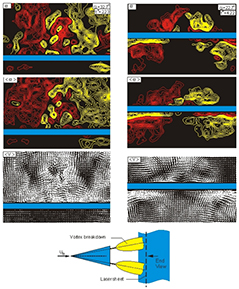You are here
Home ›Vortex Breakdown- Plate Interaction
Vortex breakdown- plate interaction. A delta wing is subjected to pitching motion about its midchord at a frequency much smaller than the inherent frequency of vortex breakdown; the consequent vortex pattern interacts with a stationary plate. The left and right columns of images show end views of the representative structure of the interaction for two instants of the wing motion. Patterns of instantaneous vorticity ω, averaged vorticity <ω> and averaged velocity <V> are indicated. In the left column, the vortex interaction process occurs primarily above the plate and patterns of large-scale positive (red line) and negative (yellow line) concentrations are evident, especially in the pattern of averaged vorticity <ω>. In addition, opposite-sign, small-scale concentrations are evident beneath each major concentration of vorticity below the plate, apparently due to eruption of the boundary layer from the surface of the plate, further suggested by the pattern of averaged velocity <V>. In the right column of images, the incident vortex breakdown is split by the plate. Regions of vorticity above the plate move closer together, while those below the plate move further apart. Layers of opposite-sign vorticity are evident beneath the major concentrations of instantaneous and averaged vorticity. All of these features are related to the buffet-loading of the plate. Mean and perturbation angle-of-attack of the delta wing are αp=30° and are αo=10° respectively.
Reduced frequency k = π feC/U = 0.74. Reynolds number is Re = 1.07x104.
A delta wing is subjected to small-amplitude perturbations over a range of periods, in order to simulate leading-edge control concepts. Substantial modifications of the instantaneous and averaged structure of the leading-edge vortex are attainable, both with and without a downstream impingement plate. The features of the vortex response are characterized using a technique of high-image-density particle image velocimetry. The location of the onset of vortex breakdown can either be advanced or retarded, and the attendant changes in vortex structure are interpreted in the context of buffeting of the impingement plate. Comparison of the vortex structure with and without deployment ofA delta wing is subjected to both static and dynamic variations of angle-of-attack; the vortices from the wing impinge upon a stationary plate. A technique of high-image-density particle image velocimetry is employed to compare the patterns of vortex development with and without the impingement plate. For the limiting case of static variations of angle-of-attack, the presence of the plate exerts a large influence on the onset of vortex breakdown. In contrast, dynamic (unsteady) variation of angle-of-attack yields changes of breakdown location that are generally similar for cases with and without the impingement plate. The detailed structure of the vortex breakdown-plate interaction is represented by patterns of instantaneous velocity and vorticity, which serve as the origin of buffet-induced loading of the surface of the plate. The plate shows a dramatic influence of the plate.

